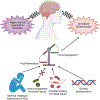Evolutionary Aspects of Diverse Microbial Exposures and Mental Health: Focus on "Old Friends" and Stress Resilience
- PMID: 35947354
- PMCID: PMC9918614
- DOI: 10.1007/7854_2022_385
Evolutionary Aspects of Diverse Microbial Exposures and Mental Health: Focus on "Old Friends" and Stress Resilience
Abstract
The prevalence of inflammatory disease conditions, including allergies, asthma, and autoimmune disorders, increased during the latter half of the twentieth century, as societies transitioned from rural to urban lifestyles. A number of hypotheses have been put forward to explain the increasing prevalence of inflammatory disease in modern urban societies, including the hygiene hypothesis and the "Old Friends" hypothesis. In 2008, Rook and Lowry proposed, based on the evidence that increased inflammation was a risk factor for stress-related psychiatric disorders, that the hygiene hypothesis or "Old Friends" hypothesis may be relevant to psychiatric disorders. Since then, it has become more clear that chronic low-grade inflammation is a risk factor for stress-related psychiatric disorders, including anxiety disorders, mood disorders, and trauma- and stressor-related disorders, such as posttraumatic stress disorder (PTSD). Evidence now indicates that persons raised in modern urban environments without daily contact with pets, relative to persons raised in rural environments in proximity to farm animals, respond with greater systemic inflammation to psychosocial stress. Here we consider the possibility that increased inflammation in persons living in modern urban environments is due to a failure of immunoregulation, i.e., a balanced expression of regulatory and effector T cells, which is known to be dependent on microbial signals. We highlight evidence that microbial signals that can drive immunoregulation arise from phylogenetically diverse taxa but are strain specific. Finally, we highlight Mycobacterium vaccae NCTC 11659, a soil-derived bacterium with anti-inflammatory and immunoregulatory properties, as a case study of how single strains of bacteria might be used in a psychoneuroimmunologic approach for prevention and treatment of stress-related psychiatric disorders.
Keywords: Anxiety; Darwinian medicine; Depression; Gut-brain axis; Hygiene hypothesis; Microbiome; Microbiota; Microbiota-gut-brain axis; Old friends; Posttraumatic stress disorder.
© 2022. The Author(s), under exclusive license to Springer Nature Switzerland AG.
Conflict of interest statement
Figures



Similar articles
-
The Microbiota, Immunoregulation, and Mental Health: Implications for Public Health.Curr Environ Health Rep. 2016 Sep;3(3):270-86. doi: 10.1007/s40572-016-0100-5. Curr Environ Health Rep. 2016. PMID: 27436048 Free PMC article. Review.
-
Treatment with a heat-killed preparation of Mycobacterium vaccae after fear conditioning enhances fear extinction in the fear-potentiated startle paradigm.Brain Behav Immun. 2019 Oct;81:151-160. doi: 10.1016/j.bbi.2019.06.008. Epub 2019 Jun 5. Brain Behav Immun. 2019. PMID: 31175996 Free PMC article.
-
Immunization with a heat-killed preparation of Mycobacterium vaccae NCTC 11659 enhances auditory-cued fear extinction in a stress-dependent manner.Brain Behav Immun. 2023 Jan;107:1-15. doi: 10.1016/j.bbi.2022.09.003. Epub 2022 Sep 13. Brain Behav Immun. 2023. PMID: 36108946
-
Subcutaneous Mycobacterium vaccae promotes resilience in a mouse model of chronic psychosocial stress when administered prior to or during psychosocial stress.Brain Behav Immun. 2020 Jul;87:309-317. doi: 10.1016/j.bbi.2019.12.018. Epub 2019 Dec 27. Brain Behav Immun. 2020. PMID: 31887415
-
Microbiota, immunoregulatory old friends and psychiatric disorders.Adv Exp Med Biol. 2014;817:319-56. doi: 10.1007/978-1-4939-0897-4_15. Adv Exp Med Biol. 2014. PMID: 24997041 Review.
Cited by
-
Mycobacterium vaccae NCTC 11659, a Soil-Derived Bacterium with Stress Resilience Properties, Modulates the Proinflammatory Effects of LPS in Macrophages.Int J Mol Sci. 2023 Mar 8;24(6):5176. doi: 10.3390/ijms24065176. Int J Mol Sci. 2023. PMID: 36982250 Free PMC article.
-
Gradient disparities in allergy and the gut microbiome among rural, migrant, and urban populations across China.World Allergy Organ J. 2024 Dec 31;18(1):101018. doi: 10.1016/j.waojou.2024.101018. eCollection 2025 Jan. World Allergy Organ J. 2024. PMID: 39845431 Free PMC article.
-
Neurobiology and systems biology of stress resilience.Physiol Rev. 2024 Jul 1;104(3):1205-1263. doi: 10.1152/physrev.00042.2023. Epub 2024 Mar 14. Physiol Rev. 2024. PMID: 38483288 Free PMC article. Review.
-
Liuwei Dihuang formula ameliorates chronic stress-induced emotional and cognitive impairments in mice by elevating hippocampal O-GlcNAc modification.Front Neurosci. 2023 Apr 20;17:1134176. doi: 10.3389/fnins.2023.1134176. eCollection 2023. Front Neurosci. 2023. PMID: 37152609 Free PMC article.
-
Examining the Relationships between the Incidence of Infectious Diseases and Mood Disorders: An Analysis of Data from the Global Burden of Disease Studies, 1990-2019.Diseases. 2023 Sep 6;11(3):116. doi: 10.3390/diseases11030116. Diseases. 2023. PMID: 37754312 Free PMC article.
References
-
- American Psychiatric Association (2013) Diagnostic and statistical manual of mental disorders, 5th edn. American Psychiatric Association, Arlington
-
- American Psychological Association (2017) Clinical practice guideline for the treatment of posttraumatic stress disorder. American Psychological Association
-
- Amoroso M, Bottcher A, Lowry CA, Langgartner D, Reber SO (2019a) Subcutaneous Mycobacterium vaccae promotes resilience in a mouse model of chronic psychosocial stress when administered prior to or during psychosocial stress. Brain Behav Immun 87:309–317 - PubMed
-
- Amoroso M, Kempter E, Eleslambouly T, Lowry CA, Langgartner D, Reber SO (2019b) Intranasal Mycobacterium vaccae administration prevents stress-induced aggravation of dextran sulfate sodium (DSS) colitis. Brain Behav Immun 80:595–604 - PubMed
MeSH terms
Substances
Grants and funding
LinkOut - more resources
Full Text Sources
Medical
Molecular Biology Databases

